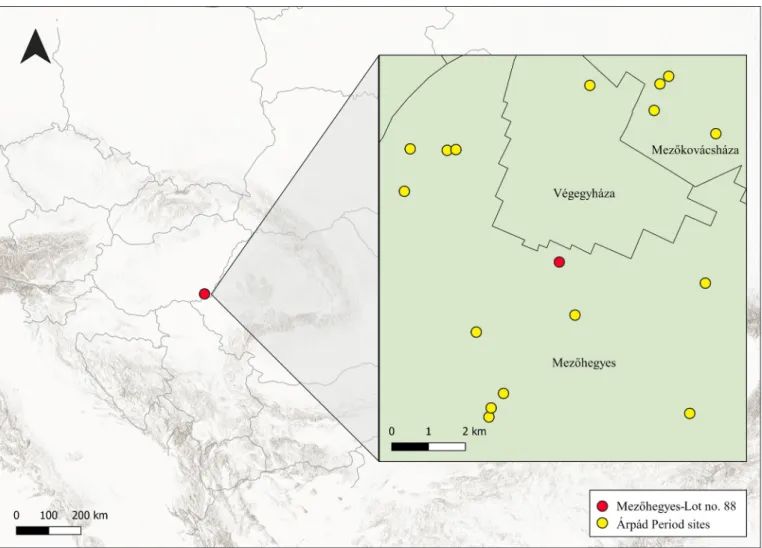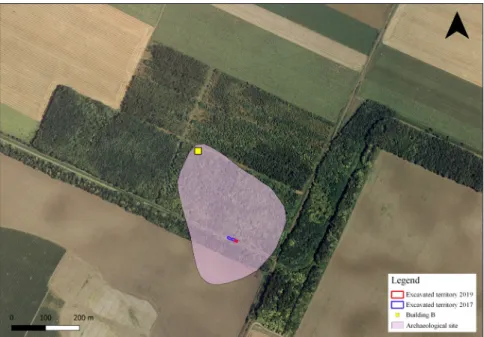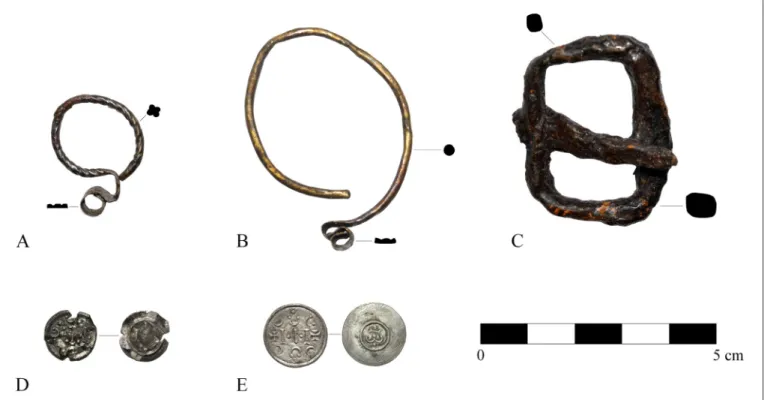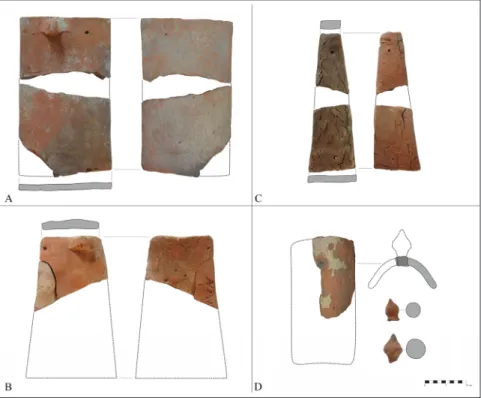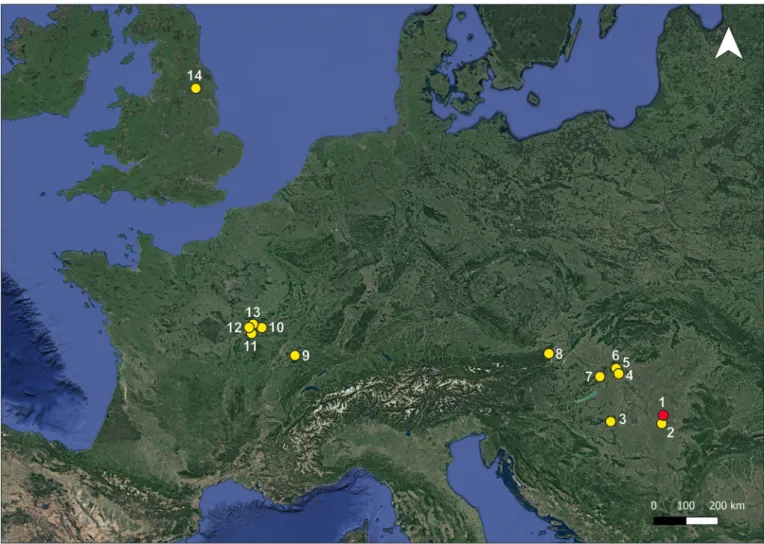ROOF TILE WORKSHOP IN MEZŐHEGYES (BÉKÉS COUNTY, HUNGARY)
GyönGyvér Bíró1
Hungarian Archaeology Vol. 9 (2020), Issue 4, pp. 31–39. doi: https://doi.org/10.36338/ha.2020.4.5
This study reports on an Árpád Period site in Mezőhegyes, where remains of an interesting structure were unearthed. Based on the design of the brickwork feature and the significant amount of corrupted roof tiles found in and around it, the structure must have functioned as a roof tile kiln. The best analogies for these roof tiles are found primarily in France (e.g., in Pontigny, Vermenton and Auxerre) and in Egres (Igriș, present- day Romania). Based on the findings, the analogies, and the history of Egres, it seems that the roof tile kiln of Mezőhegyes operated in the 12th century and can be connected to the activities of the Cistercian Order.
ARCHAEOLOGICAL RESEARCH IN MEZŐHEGYES
Various minor settlement traces from the Árpád Period and a contemporaneous cemetery were discovered at the site called Mezőhegyes–88-as tábla (‘Lot no. 88’) (Fig. 1). The site is located in Southeast-Hungary in Békés county, at the northern border of the town of Mezőhegyes. The area of the settlement and its cemetery stands out slightly from its surroundings, the highest point being the central part, where the former church
1 Department of Archaeology, University of Szeged. E-mail: gyongyver.br@gmail.com
Fig. 1. The site of Mezőhegyes and other Árpád Period sites within a 5 km range (the map is based on: Esri, Airbus DS, USGS, NGA, NASA, CGIAR, N Robinson, NCEAS, NLS, OS, NMA, Geodatastyrelsen, Rijkswaterstaat, GSA, Geoland, FEMA,
Intermap and the GIS user community; © OpenStreetMap collaborators)
can be suspected (see the map of the Second Military Survey). The ter- ritory looks interesting in the First Military Survey, as the lanes on the map may reflect preserved traces of a former road network, elements of which converge at the archaeologi- cal site. 130 years ago, a large chan- nel (called Élővíz-főcsatorna, ‘Live Water’ Channel) was dug in the area (TóTh 1969, 120), during which several graves were disturbed, but the site was not publicized. It was György Kerekes who drew the attention of the archaeologists at the Nagy Gyula Regional Museum to the site. Ceramic fragments and copper coins minted during the reign of Béla III (1172–1196) suggested the presence of a former settlement northwest of the cemetery, where the remains of a brick structure (Building B) were also found (Fig.
2). In 2017 we carried out the first excavation at the site, because it was endangered by the channel. During the excavation parts of the Árpádian Age churchyard, an earlier ditch and a roof tile kiln with an ash pit were brought to light (Figs. 3–4). In 2019 another excavation was conducted with the cooperation of the museum and the Department of Archaeology of the University of Szeged, during which further graves and the contin- uation of the ditch were identified.
Fig. 2. The location of the site Mezőhegyes–88-as tábla (orthophoto by Lechner Non-profit Ltd.)
Fig. 3. The excavated area and the hypothetical extension of the cemetery around the church (orthophoto by Lechner Non-profit Ltd.)
Fig. 4. The area excavated in 2017
CHURCHYARD – WITHOUT A CHURCH?
We excavated 92 graves and 38 features consisting of human remains and fragments of brick and roof tiles.
The deceased were wrapped in a shroud or buried in a coffin. In almost all cases, the deceased lay on their backs in an extended position, their arms were stretched out next to their bodies or folded on their pel- vis. Superpositions were common in the churchyard, and several graves were disturbed by newer burials;
remains from the disturbed earlier graves were simply pushed aside and piled up before they were buried back. In such cases, only a few items of clothing (hoop jewellery, belt buckle), coins given as funeral oboli (12th-century anonymous silver coins), pins for fixing the shroud, and the ironings and nails of the coffins were uncovered (Fig. 5). Based on the grave findings, the churchyard was used in the 12th century, but the dating of the site may change in the light of future research results. In several cases, bricks and brick fragments framing the grave or placed above or next to the deceased were observed, and in some cases, corrupted or melted roof tile fragments also came to light from among them. Although the church itself has not yet been found, its existence is suggested by these phenomena. Gradually moving to the southeast dur- ing the excavation, burials became more and more frequent, there was more building material debris, and the frequency of superpositions between the graves also increased. All this suggests that the former church must be close. Its building material might have been produced locally, as the material analysis of the kiln and the building ceramics suggest (KreiTer et al., 2018).
THE ROOF TILE KILN OF MEZŐHEGYES AND ITS PRODUCTS The roof tile kiln
The rectangular structure, built of mortar bricks, stood on the bank of the present canal, and therefore, its southern half was destroyed during the construction of the waterway. The bottom segment of the back wall could be observed in situ, and it is possible to reconstruct the complete floor area of the structure. The size of the roof tile kiln was ca. 2×3 m, it had two fire channels and an arched structure (Fig. 6). The kiln was built on yellow, clayey subsoil, and at least a part of it was below the one-time floor level. Three parallel wall structures of the kiln were preserved in a fragmented state (a 240 cm long segment of the northeast wall, 126 cm of a wall in the middle, and a 41 cm long section of the southwest wall was preserved). Its
Fig. 5. Various findings from the cemetery, A–B: hoop jewellery; C: iron buckle; D–E: anonymous denarii from the 12th century
bottom was red, firm and burnt through in 10 cm depth. In the north-eastern outer wall – which was preserved in the best condition – every second brick was placed in a tilted position, skewed to the direc- tion of the middle wall, indicating that there were arches here, which separated the upper kiln chamber from the fire chamber below. Lots of discarded and broken roof tiles came to light from inside the struc- ture and in its surroundings, making it clear that we found a roof tile kiln. There was an ash pit approxi- mately 80 cm northwest of the kiln, which was full of roof tile fragments, ash, and remains of charcoal.
The building material of the kiln was probably sec- ondarily used after it ceased to function, and it may have even been used in building the tomb structures of the graves, as some of the used (mortared) brick fragments from the burials suggest.
Although the term ‘workshop’ is used in this paper, it is important to note that to date, only the kiln, the ash pit and the discarded pieces point to the one-time industrial activity. The building itself, where the tiles were prepared and temporarily stored (i.e., the actual workshop building), has not yet been found.
The roof tiles of Mezőhegyes
Most of the roof tiles came from the kiln and its surroundings, but we found several fragments of appar- ently used roof tiles in the area of the churchyard as well. As most of the tiles we found can be considered as waste from the workshop, it is challenging to reconstruct them, as they are primarily fragments and corrupted (poorly burnt, grey-purple-green, fractured or swollen) pieces. According to the current state of research, four main types of roof tiles can be distinguished (Fig. 7); however, no whole tile has been found so far, nor has it been possible to assemble a whole piece from the unearthed fragments, and so the data on their dimensions refers to the hypothetically reconstructed pieces.
Type 1 is a large, rectangle tile with a knob on one side of its upper section and a small hole on the other side. Right and left side pieces were both present. Known dimensions:
32×21×1.5 cm. This is considered the most common type of roof tiles so far; there were hundreds of such fragments in Mezőhegyes (Fig. 7 A). Type 2 is a medium-sized, trap- ezoidal tile with a knob on one side of its upper part and a small hole on the other side. Right and left side pieces were both found. Known dimensions: 16.7×13–16×2.2–2.5 cm (Fig. 7 B). Type 3 is a large, nar- row trapezoidal tile with small holes in its upper and lower part, and it has no knob. There was also one piece without a hole. Known dimensions:
30.5×5–14.5×1.7–1.8 cm (Fig. 7 C).
Fig. 6. Excavation photo of the Mezőhegyes kiln and the associated ash pit
Fig. 7. The Mezőhegyes roof tile types, A: Type 1; B: Type 2; C: Type 3;
D: Type 4
Type 4 is a ridge-tile with a bulbiform decoration. Some of the ridge-tiles showed traces of light coloured, greenish white glaze. Known dimensions: 18.5×12.5×2 cm, bulbiform decoration: 5–6.5×2–3 cm (Fig. 7 D).
Type 1 might have been arranged in rows for roofing: the lower end of the top row covered the perforated upper part of the row below, and in addition to the knob resting on the purlin, the tiles were also fixed to each other with a nail that was driven through the hole (ViolleT-le-Duc 1868, 328–329). Type 2 and 3 may have been used at the end of the tile rows, while Type 4 was probably used on roof ridges. The functional division is also supported by the frequency of these types, but of course, the future excavation of the church may change these ratios.
DATING THE KILN AND THE ROOF TILES
Kilns and workshops similar to the one discovered at Mezőhegyes were used in Western and Central Europe in the 13th–15th century. They were used in many places to produce a range of building materials, such as roof and floor tiles and bricks; usually, one or more channel kilns with grates or arches were used in these workshops. Most kilns, like the kiln found at Mezőhegyes, were semi-subterranean and had two fire chan- nels(eames 1961, 139; JaKab 2008, 359). However, their function and dating are often doubtful, as some- times no products are found associated with them, or the unearthed artefacts cannot be dated precisely. In Mezőhegyes, dating was made possible by the pottery we found next to the roof tiles and bricks in the kiln, which were all from the Árpád Period. Moreover, in some cases there were roof tile fragments in the graves mixed with finds such as 12th century coins, hoop jewellery, pin, or coffin ironings. One grave was sur-
Fig. 8. Monasteries and sites mentioned in the paper, in Hungary and abroad, 1. Mezőhegyes–88-as tábla, 2. Egres (Igriș, Romania), 3. Cikádor, 4. Margaret Island, 5. Pomáz–Nagykovácsi, 6. Pilis, 7. Vértesszentkereszt, 8. Heiligenkreuz (Austria), 9. Acey (France), 10. Quincy (France), 11. Vermenton (France), 12. Auxerre (France), 13. Pontigny (France), 14. York (UK)
(the map is based on Google)
rounded by brick pieces, and in this heap we found two corrupted and melted roof tiles. These suggest that both the roof tile workshop and the churchyard were in use in the middle of the Árpád Period. In Hungary, A. Jakab studied medieval kilns (brick, floor and roof tile kilns) relatively recently (JaKab 2011); so far, no roof tile kilns have been found that could have been dated to such an early period of medieval Hungary.
Among the medieval roof tiles in Hungary, ridge-tiles, beaver-tailed and sometimes rectangular shapes also occur, however, older publications sometimes neglect to discuss the shape or the dating of these objects.
There is only limited information about the early tiles that date back to the Árpád Period. The roof of the 12th–16th-century building of the abbey of Vértesszentkereszt was covered with glazed roof tiles(KozáK
1965, 85). The roof tiles of the Cistercian abbey of Pilis presumably date to the 13th century (holl 2000, 17, 48). Between the second half of the 13th and the beginning of the 16th century, cogged tiles were also made, which were discovered around the Dominican monastery on Margaret Island (KáDár 2012, 15).
These archaeological assemblages sometimes date from the 14th, but mostly from the 15th–16th century.
Such specimens are primarily known from royal centres, cities, towns, and from the context of different monastic communities and ecclesiastical buildings (bíró 2019, 29). Relatively few tiles are known from Hungary, and these date typically later than those unearthed in Mezőhegyes, and so analogies have been found mainly abroad, primarily in France (Fig. 8). There are several analogies to the tile types present at Mezőhegyes (Mh), here I only name a few examples. The most abundant Mh-Type 1 shows the most resem- blance to the type Pont-T4 from Pontigny, in both size and design(aumarD et al. 2019, 20, fig. 3). Type Set-D5 from Auxerre(aumarD et al. 2019, 22, fig. 4) and type Ver-T3a from Vermenton have similar design features too (aumarD et al. 2019, 24, fig. 5). These tile types date back to 1020–1180 (Pont-T4), 1110–1230 (Set-D5), and 895–1095 (Ver-T3a), respectively, based on thermoluminescence measurements(aumarD et al. 2019, 29, fig. 10). A type similar to the above-mentioned tile from Pontigny is known from Quincy (Type 4) (aumarD 2009). The roof tile type called ‘Count Henri’s tile’ has the same size and form as Mh-Type 1. Its earliest exemplars date back to the 13th century (ViolleT-le-Duc 1868, 326). A trapezoidal roof tile similar to Mh-Type 2 is known from Auxerre (Set-B2), although it has a knob in the centre, two holes below it, and lead glaze was applied on it (aumarD et al. 2016, 186, fig. 152). The ridge-tiles known from Auxerre from the 12th–14th century were decorated with one or two ornaments, while those from Vermenton usu- ally had one ornament (aumarD & sapin 2017). Based on the excavation results and the analogies, the roof tile kiln of Mezőhegyes probably operated in the 12th century.
Of course, the exact chronology of the church, the churchyard and the kiln cannot be unambiguously established without exploring the church building. However, it seems certain that both the churchyard and the roof tile kiln were in use in the 12th century.
OUTLOOK – CONNECTIONS OF THE MEZŐHEGYES WORKSHOP
It has been raised earlier that the age of the kiln, the analogies found mainly in France, as well as the his- tory of the region around Mezőhegyes may suggest the presence of Cistercians or, at least, their impact (bíró 2019, 30). The distance between the Egres monastery (Igriș, Romania) and the archaeological site of Mezőhegyes is 23 km as the crow flies, and they are also chronologically close. The Egres monastery was founded by Béla III (1172–1196) in 1179 as an affiliate of the Cistercian abbey of Pontigny(rupp 1876, 68;
bácsaTyai 2015, 267). In the summer of 2019, my colleagues and I had the opportunity to visit the exca- vation at the monastery of Egres, led by the Museum of Banat jointly with the Institute of Archaeology of Pázmány Péter Catholic University.2 During our visit at the monastery of Egres, several roof tiles came to light that were completely identical to those found at Mezőhegyes. We were unable to examine all the tiles, but it was clear that in terms of design and size they were similar to Type 1 tiles, the most common roof tile type at Mezőhegyes, and its analogies from France. Tiles similar to Type 4 were also found among the finds in Egres. The same way the activities in the mother abbeys’ – Heiligenkreuz (Austria) and Acey (France) – workshops could be observed at the monasteries of Cikádor and Pilis (ValTer 2009, 131, 144–145), the
2 I would like to thank Daniela Tănase, Balázs Major and Péter Langó for the opportunity to see the excavation and the finds.
relationship with Pontigny can be detected in the case of Egres. At first sight it was evident that the roof tile material from Mezőhegyes is much more homogeneous than the assemblage found in Egres. The mon- astery’s building was completed in 1187 (rupp 1876, 69), and it was restored after the Mongol Invasion (Tânase et al. 2017, 230). Presumably, the different versions of the same tile type can be associated with the monastery’s construction periods or different masters working in a large workshop. This may be clarified by the scientific study of the Egres material. The homogeneity within the Mezőhegyes roof tile types may be indicative of the short-term operation of the workshop, or the small number of masters who worked there.
At present, the exact period when the kiln at Mezőhegyes operated cannot be established. If one accepts the connection with the Egres monastery, the earliest date when the workshop may have started operating is after the foundation of the monastery in 1179. However, the anonymous 12th-century denarii found in graves, which included pieces dated to an earlier period, seem to contradict this hypothesis. Nevertheless, the connection between these coins and the rulers is sometimes uncertain, moreover, the coins may have been buried much later than their time of issue, and it is also possible that the roof tiles were needed and made to cover the roof of the church (perhaps even after its original construction). This is, however, only a hypothesis, and further research is needed to date the operation of the roof tile kiln more accurately.
Medieval industrial units in the United Kingdom, such as building ceramics workshops, have been grouped according to the purpose and method of production, the identity of the maker and the location of the work- shop. Based on the presently available information, the workshop in Mezőhegyes was not a migrant or temporary site, but a settled, in-house production site, which was tied to the monastic order and produced mainly roof tiles for the community that operated the kiln (sTopforD 1992, 344, 348). Kilns in this group were generally small in size and well-built, and usually made only one product (sTopforD 1992, 357).
The industrial activity as well as the network of relationships between individual abbeys and their sur- roundings are made evident by the archaeological findings. Already at Cikádor, the first Hungarian monas- tery of the Cistercians, one finds the forerunners of the floor tiles produced by the ceramics workshop of the Pilis monastery, which operated from the 1360s onwards. These tiles were produced in the Pilis workshop not only for the churches of the order, but also for others, especially people in their immediate surroundings (holl 2000, 62–65). A similar relationship can be seen in the town of York (UK), where mosaic floor ele- ments, which are specifically associated with the Cistercians, were found (mccomish 2015, 31, Plate 28).
The Pilis monastery was involved in various industrial activities, which is also evidenced by the workshop buildings excavated in Pomáz–Nagykovácsi, once the territory of the Cistercian manor (laszloVszKy &
sTarK 2017, 241). The grange was established here around the former Árpád Period church, which contin- ued to function as a chapel (laszloVszKy et al. 2014, 8). Several workshop buildings and kilns were set up here, in which traces of glassmaking could be observed. Special ceramic elements were also used: various bricks were made to build the kilns, crucibles for melting the glass, and other ceramic tools for making and shaping the glass (laszloVszKy & sTarK 2017, 243–257). A similar market region can be assumed for glass products as for building ceramics of the monastery of Pilis (laszloVszKy & sTarK 2017, 261).
In the light of the above and taking into account the historical and archaeological connections, it is likely that the church of Mezőhegyes and the surrounding settlement traces, as well as its one-time inhabitants, belonged in some way to the Cistercian monastery in Egres; the structures unearthed at Mezőhegyes may have even been part of the grange of the Egres monastery. This would explain the relationship with the Pontigny roof tiles. With this in mind, not only the church in Mezőhegyes, but also ‘Building B’ deserves more attention in the future.
ACKNOWLEDGEMENTS
Colleagues at the Nagy Gyula Regional Museum, their family members and friends, students of the Depart- ment of Archaeology at the University of Szeged, and students of the Kozma Ferenc Agricultural Vocational School and College participated in the excavation. The geodetic survey was carried out by Archeoline Ltd.
The metal finds were restored by Boglárka Lengyel. I hereby thank all of them for their help.
recommenDeDreaDings
Aumard, S., Ben Amara, A., Büttner, S., Cantin, N., Zink, A. & Porto, É. (2019). Les premiéres tuiles plates en Auxerrois (XIIe–XIIIe siécles): approche typologique et archéométique. In Thuillier, F., Les terres cuites architecturales en France du Moyen-Âge à l’époque contemporaine : recherches sur les tuileries et les productions tuilières (pp. 15–38). Mergoil: Archéologie Moderne Contemporaine. https://hal.archives- ouvertes.fr/hal-02093829
Ferenczi, L. (2018). Management of Monastic Landscapes. A Spatial Analysis of the Economy of Cistercian Monasteries in Medieval Hungary. PhD Dissertation. Department of Medieval Studies, Central European University, Budapest.
Koszta, L. (1998). Die Gründung von Zisterzienklöstern in Ungarn 1142–1270. Ungarn-Jahrbuch.
Zeitschrift für die Kunde Ungarns und verwandte Gebiete 23 (1997), 65–80.
bibliography
Aumard, S. & Sapin, C. (2017). Matériaux et archéologie du bâti en Bourgogne : quels enjeux pour l’histoire de la construction? Recorded presentation. https://www.youtube.com/watch?v=OMVLc2BuIQE&t=654s (Last accessed: 22 Aug 2018)
Aumard, S. (2009). Les tuiles médiévales de l’abbaye cistercienne de Quincy (Tanlay, Yonne), 2007–2008. Bulletin du centre d’études médiévales d’Auxerre, BUCEMA [En ligne] 13, 97–98. https://doi.org/10.4000/cem.11309 Aumard, S., Ben Amara, A., Büttner, S., Cantin, N., Lanos, P., Dufresne, P., Zink, A. & Porto, É. (2016). La couverture monumentale en chantier. Les cathédrales d’Auxerre et Sens d’aprés les données archéologiques, archéométriques et historiques. In F. Duperroy & Y. Desmet (eds.), Les couvertures médiévales. Images et techniques (pp. 181–193). Namur, Études et Documents, Monuments et Sites 14. Namur: Institut du Patrimoine Wallon, Service Publications. https://hal.archives-ouvertes.fr/hal-01961883
Aumard, S., Ben Amara, A., Büttner, S., Cantin, N., Zink, A. & Porto, É. (2019). Les premiéres tuiles plates en Auxerrois (XIIe–XIIIe siécles): approche typologique et archéométique. In F. Thuillier, Les terres cuites architecturales en France du Moyen-Âge à l’époque contemporaine : recherches sur les tuileries et les productions tuilières (pp. 15–38). Mergoil: Archéologie Moderne Contemporaine. https://hal.archives- ouvertes.fr/hal-02093829
Bácsatyai, D. (2015). Az egresi ciszterci monostor korai történetének kérdései [On the early history of the Cistercian monastery of Egres]. Századok 149 (2), 263–299.
Bíró, Gy. (2019). Árpád-kori tetőcserép-égető kemence a mezőhegyesi határban [An Árpád Period roof tile kiln near Mezőhegyes]. In Herczig B. (ed.), Tetőcserepek és téglák (pp. 25–31). Jeles téglák, jeles emlékeink 6. Baj: Monarchia BTE.
Eames, E. (1961). A thirteenth-century tile kiln site at North Grange, Meaux, Beverley, Yorkshire. Medieval Archaeology 5 (1), 137–168. https://doi.org/10.1080/00766097.1961.11735650
Holl, I. (2000). Funde aus dem Zisterzienserkloster von Pilis. Varia Archaeologica Hungarica 11. Budapest:
Archäologisches Institut der UAW.
Jakab, A. (2008). Égetőkemencék az európai régészeti anyagban [Kilns in European archaeological assemblages]. A nyíregyházi Jósa András Múzeum Évkönyve 50, 357–366.
Jakab, A. (2011). Téglaégető kemencék a középkori Magyarországon [Brick kilns in medieval Hungary].
A nyíregyházi Jósa András Múzeum Évkönyve 53, 131–160.
Kádár, J. (2012). A magyarországi tetőcserepek fajtái [Hungarian roof tile types]. In Herczig B. (ed.), Tetőcserepek és téglák (pp. 5–82). Jeles téglák, jeles emlékeink 6. Baj: Monarchia BTE.
Kozák, É. (1965). 143. Vértesszentkereszt. In Sz. Burger A. (ed.), Az 1964. év régészeti kutatásai (pp. 83–83). Régészeti Füzetek 18. Budapest: Magyar Nemzeti Múzeum & Történeti Múzeum.
Kreiter, A., Skoda, P., Kristály F. & Kelemen, É. (2018). Mezőhegyes 88-as tábla lelőhely Árpád-kori tégla- és tetőcserép töredékeinek petrográfiai vizsgálata [The petrographic analysis of Árpád Period brick and roof tile fragments from the site Mezőhegyes – 88-as tábla]. In Bíró Gy., Katona-Kiss A. & Rózsa Z. (eds.), Fémek a földből I (pp. 77–85). Orosháza és vidéke múltjából 19. Orosháza: Orosháza Város Önkormányzat Nagy Gyula Területi Múzeuma.
Laszlovszky, J., Mérai, D., Szabó, B. & Vargha, M. (2014). The ‘Glass Church’ in the Pilis Mountains.
Hungarian Archaeology 3 (4) [2014 Winter], 1–11.
Laszlovszky, J. & Stark, K. (2017). Medieval glass production at Pomáz-Nagykovácsi: The finds and heritage interpretation of an archaeological site. Annual of Medieval Studies at CEU 23, 239–264.
McComish, J. M. (2015). A Guide To Ceramic Building Materials. An Isight Report. York Archaeological Trust. Finding the Future. York: York Archaeological Trust for Excavation and Research.
Rupp, J. (1876). Magyarország helyrajzi története fő tekintettel az egyházi intézetekre [The topographic history of Hungary, with a special focus on ecclesiastic institutions]. Vol. 3. Budapest: A Magyar Tudományos Akadémia Történelmi Bizottsága.
Stopford, J. (1992). The organisation of the medieval tile industry. Oxford Journal of Archaeology 11 (3), 341–363.
Tânase, D., Bertók, G., Kocsis, A. & Major, B. (2017). The location of Egres Cistercian monastery – Igriş (Timiş County), in the light of recent geophysical research. Ziridava Studia Archaeologica 31, 229–327.
Tóth, I. (1969). Mezőhegyes, szorosabban a mezőhegyesi állami gazdaság története [The history of Mezőhegyes and the Mezőhegyes State Farm]. Unpublished manuscript.
Valter, I. (2009). A középkori magyar ciszterci monostorok alaprajzi és építészeti sajátosságai [Characteristic ground plans and architectural features of Cistercian monasteries in medieval Hungary]. In Guitman B.
(ed.), A ciszterci rend Magyarországon és Közép-Európában (pp. 127–145). Piliscsaba: Pázmány Péter Katolikus Egyetem Bölcsészettudományi Kar.
Viollet-le-Duc, E. (1868). Dictionnaire raisonné de l’architecture française du XIe au XVIe siècle. Tome 9. Paris: Morel A.
